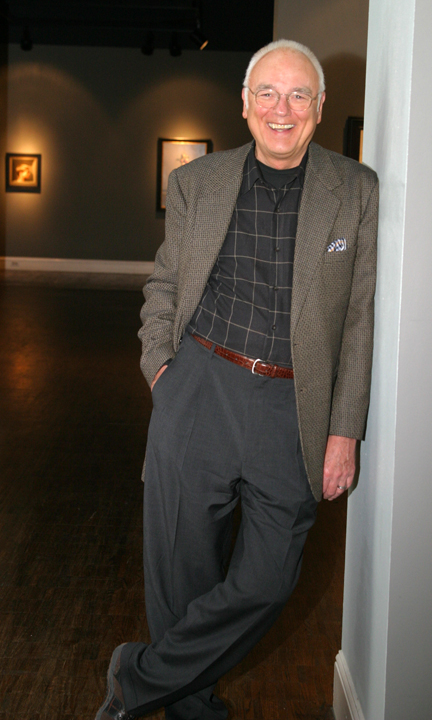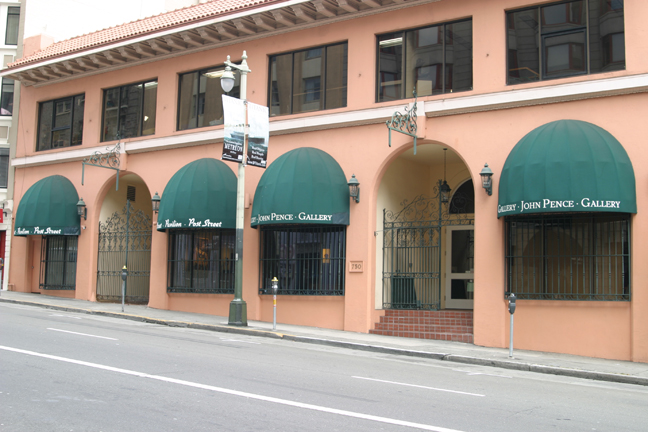Riches Beyond Imaginingby Howard Hewitt |
| Printer-friendly version | Email this article |
|
Being a gay naval officer was uncomfortable.
But being denied promotions because of his sexuality —that built frustration and anger.
John Pence ’58 struggled with or hid his sexual identity until the early 1980s, but he’s since become an art world icon and one of San Francisco’s most influential gay leaders.
He’s been an aide to President Lyndon Johnson, negotiated international airfares, rejuvenated American Academic Realism painting, and helped build the fastest- growing gay, lesbian, bisexual, transsexual charity in the country. Read more about his work with the Point Foundation by clicking here.
"I grew up in a home where my mother loathed blacks and Jews," Pence says with the same exasperation he must have felt as a teen. "She had utter contempt for the idea of gays. It made me feel I wasn’t living who I actually was. In order to fit in, I had to live who I was not."
Today the 70-year-old Pence is an activist, a visionary, and the owner of the John Pence Gallery in downtown San Francisco. He is also president of the board of trustees for the Point Foundation, which funds college scholarships for disenfranchised gay, lesbian, bisexual, and transsexual youth. It currently has assets of $8 million, and it’s growing.
Pence came out to friends and associates in the early 1980s, largely to help tackle the AIDS crisis crippling San Francisco at the time. He calls this Wabash Magazine interview—"coming out to so many at age 70—an interesting experience."
But with his private life in the closet for nearly 40 years, the Fort Wayne native went about building a remarkable career and a lifetime of even more remarkable stories and achievements. "In my day you had to hide in order to have opportunities," Pence says.
He served nine years in the Navy and became a military social aide to President Lyndon and Lady Bird Johnson.
"He was a good man," Pence says, "but she was a better woman."
Pence got the job at the White House in part because he could play bridge. He’d often join Lady Bird and daughter Lynda Bird in the private quarters for cards.
"I was just learning from them, listening to their conversations. I trusted them more than Republicans."
His White House tour of duty landed him a job with TWA, where his Wabash political science and economics courses were put to work negotiating international airfares. It was during those seven years with TWA that Pence developed an interest in art.
"I was visiting all these places—Lisbon one day, Rio the next—and I found it an exhausting seven-days-a-week job. So lunchtime was my only time to get away.
I found this respite. I’d inquire how these gallery owners did it and they made it sound so simple."
Pence would see prints in Japan, great works in the old European cities, and the latest artists in Geneva. Hear Pence talk about good paintings by clicking here.
"You’d see some of these artists when they were new and could spot them as someone who was going to ‘happen.’ I’d buy one or two [pieces]."
But at TWA, Pence found himself stuck beneath a glass ceiling. He was not open about his sexuality, but describes himself in those days as a sensitive and kind person who was "different."
"I felt I was doing twice the work as my straight contemporaries. I was being used as an effective mouthpiece, but I just wasn’t getting the jobs I wanted."
Pence’s work with TWA caught the attention of Knut Hammerskjold, the director general for the Interna-tional Air Transport Association. Hammerskjold named Pence IATA’s senior economist and high commissioner of commercial planning. His successes there included negotiating one of the first international agreements with the USSR’s Aeroflot.
"I’ve always been a negotiator, even at Wabash. As fraternity president, you had to negotiate between several cliques. In the Delt House it was primarily the academics versus the athletes. They were strong contingents. I wasn’t either."
The speaking skills learned from legendary Wabash Professor of Speech William Norwood Brigance came in handy during negotiations, too.
"In Brigance’s class, you just got used to that sort of a role."
Pence picked San Francisco partly because it was a gay- friendly city.
"There are so many different cultures here, and so little prejudice," Pence observes. "You really can’t afford to be prejudiced here."
There was also only one realist gallery in San Francisco at the time, and that spelled opportunity for Pence, who wanted to specialize in that art form.
"Abstraction to me is willy-nilly; I can’t explain it and in many cases it doesn’t require great skill. Realism isn’t the same. It requires skills, like those of Michelangelo or John Singer Sargent. These artists go to school and meet standards. They have to draw and they have to understand color. We all know what it is that they’re depicting, so we know whether they’re good or bad."
Perhaps it was the disdain he saw in his mother toward the underdogs in life, or even his own underdog status as a homosexual, but Pence gravitated toward younger artists when he opened his gallery.
"I’ve always enjoyed choosing and evaluating things. Even as a boy, I would line up objects to decide which one was best."
One of his first choices was the work of landscape painter Robert Maione, who after being represented by Pence went on to international critical acclaim from critics and collectors.
"These young artists were struggling; they didn’t have any audience," he explains.
At the time, museums weren’t supporting realism.
"They didn’t have any living painters. Their meat and potatoes was dead people," he recalls. "We’re running out of dead people."
Pence frequently re-visited New York and encouraged other gallery owners to support younger artists. But with the high costs of gaspace and other economic realities making such support difficult, the revival of American realism started on the West Coast, and largely because of John Pence.
"We became the primary tryout place for these artists," Pence explains.
Today, he has a stable of 40 artists who show their work in his gallery, one of the "premier Academic Realist galleries in the U.S."
"The sophistication of the American painting market has gone up markedly in the 32 years I’ve been here," Pence says. "When I started, nobody wanted to buy a portrait because they would say, ‘I don’t know these people and what would people say if they came into my home?’ Eventually that changed, and now interiors are popular, still lifes are popular. Those things weren’t selling in this country when I opened the business. For the most part, then, it was landscapes."
John Pence’s energy extends beyond the gallery that bears his name. He’s frequently hosted charitable events and political fundraisers for candidates, including Barbara Boxer, Diane Feinstein, and current Speaker of the House Nancy Pelosi.
"I think I’ve hosted a fundraiser for every woman who ever ran for anything in this city," he says with a laugh.
He’s also worked with Project Open Hand, the AIDS Emergency Fund, Junior League of San Francisco, world-renowned a capella group Chanticleer, the San Francisco Library, Project Read, Gay Men’s Chorus, and many others groups.
Today he splits his time between the gallery and his work with the Point Foundation.
He isn’t slowing down. He has made a commitment to run the gallery until he turns 75. He has understandings with his artists and other galleries for options upon his retirement or death.
John Pence’s life has allowed him to rub elbows with the very famous and very wealthy.
"I never sought riches," he says, sitting in a small room off the gallery’s main floor. "But wealthy people are the people who buy art, and I enjoy their company. If you’re honest with them, they’re some of the nicest people on the face of the earth. They’re fun—and they enjoy discovering contemporary artists."
That’s a joy Pence shares—a joy that’s been a focus of his life.
"I was criticized by my family for not seeking riches. That just never intrigued me."
Pence found his riches in being himself, helping others, and trying to be a "kind person."
They are riches beyond what he ever imagined.
Visit the John Pence Gallery at www.johnpence.com
|

 Being gay at Wabash in the 1950s wasn’t easy.
Being gay at Wabash in the 1950s wasn’t easy. But Pence’s candor about the airline industry in an interview with The Economist and The Times of London may have proved too much for Hammerskjold, who fired him. Pence took his $19,000 settlement and eventually headed for San Francisco, where his ability to connect with people paid off again. The head of Lufthansa Airlines was aware that John wanted to start a gallery and knew a German businessman in San Francisco who gave John a huge break by getting him into a downtown Sutter Street location at far less than market value.
But Pence’s candor about the airline industry in an interview with The Economist and The Times of London may have proved too much for Hammerskjold, who fired him. Pence took his $19,000 settlement and eventually headed for San Francisco, where his ability to connect with people paid off again. The head of Lufthansa Airlines was aware that John wanted to start a gallery and knew a German businessman in San Francisco who gave John a huge break by getting him into a downtown Sutter Street location at far less than market value.